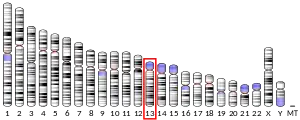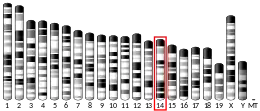Gap junction beta-2 protein (GJB2), also known as connexin 26 (Cx26) — is a protein that in humans is encoded by the GJB2 gene.
Clinical significance
Defects in this gene lead to the most common form of congenital deafness in developed countries, called DFNB1 (also known as connexin 26 deafness or GJB2-related deafness).[5] One fairly common mutation is the deletion of one guanine from a string of six, resulting in a frameshift and termination of the protein at amino acid number 13. Having two copies of this mutation results in deafness.[6]
Connexin 26 also plays a role in tumor suppression through mediation of the cell cycle.[7] The abnormal expression of Cx26, correlated with several types of human cancers, may serve as a prognostic factor for cancers such as colorectal cancer,[8] breast cancer,[9] and bladder cancer.[10] Furthermore, Cx26 over-expression is suggested to promote cancer development by facilitating cell migration and invasion[11] and by stimulating the self-perpetuation ability of cancer stem cells.[12]
Function
Gap junctions were first characterized by electron microscopy as regionally specialized structures on plasma membranes of contacting adherent cells. These structures were shown to consist of cell-to-cell channels. Proteins, called connexins, purified from fractions of enriched gap junctions from different tissues differ. The connexins are designated by their molecular mass. Another system of nomenclature divides gap junction proteins into two categories, alpha and beta, according to sequence similarities at the nucleotide and amino acid levels. For example, CX43 (GJA1) is designated alpha-1 gap junction protein, whereas GJB1 (CX32), and GJB2 (CX26; this protein) are called beta-1 and beta-2 gap junction proteins, respectively. This nomenclature emphasizes that GJB1 and GJB2 are more homologous to each other than either of them is to gap junction protein, alpha GJA1.[13]
See also
References
- 1 2 3 GRCh38: Ensembl release 89: ENSG00000165474 - Ensembl, May 2017
- 1 2 3 GRCm38: Ensembl release 89: ENSMUSG00000046352 - Ensembl, May 2017
- ↑ "Human PubMed Reference:". National Center for Biotechnology Information, U.S. National Library of Medicine.
- ↑ "Mouse PubMed Reference:". National Center for Biotechnology Information, U.S. National Library of Medicine.
- ↑ Kelsell DP, Dunlop J, Stevens HP, Lench NJ, Liang JN, Parry G, Mueller RF, Leigh IM (May 1997). "Connexin 26 mutations in hereditary non-syndromic sensorineural deafness". Nature. 387 (6628): 80–3. Bibcode:1997Natur.387...80K. doi:10.1038/387080a0. PMID 9139825. S2CID 4311728.
- ↑ Zytsar MV, Barashkov NA, Bady-Khoo MS, Shubina-Olejnik OA, Danilenko NG, Bondar AA, et al. (August 2018). "Updated carrier rates for c.35delG (GJB2) associated with hearing loss in Russia and common c.35delG haplotypes in Siberia". BMC Medical Genetics. 19 (1): 138. doi:10.1186/s12881-018-0650-5. PMC 6081885. PMID 30086704.
- ↑ Tanaka M, Grossman HB (February 2004). "Connexin 26 induces growth suppression, apoptosis and increased efficacy of doxorubicin in prostate cancer cells". Oncology Reports. 11 (2): 537–41. PMID 14719096.
- ↑ Nomura S, Maeda K, Noda E, Inoue T, Fukunaga S, Nagahara H, Hirakawa K (June 2010). "Clinical significance of the expression of connexin26 in colorectal cancer". Journal of Experimental & Clinical Cancer Research. 29 (1): 79. doi:10.1186/1756-9966-29-79. PMC 2907868. PMID 20565955.
- ↑ Teleki I, Krenacs T, Szasz MA, Kulka J, Wichmann B, Leo C, Papassotiropoulos B, Riemenschnitter C, Moch H, Varga Z (February 2013). "The potential prognostic value of connexin 26 and 46 expression in neoadjuvant-treated breast cancer". BMC Cancer. 13: 50. doi:10.1186/1471-2407-13-50. PMC 3583680. PMID 23374644.
- ↑ Gee J, Tanaka M, Grossman HB (March 2003). "Connexin 26 is abnormally expressed in bladder cancer". The Journal of Urology. 169 (3): 1135–7. doi:10.1097/01.ju.0000041954.91331.df. PMID 12576868.
- ↑ Kotini M, Mayor R (May 2015). "Connexins in migration during development and cancer". Developmental Biology. 401 (1): 143–51. doi:10.1016/j.ydbio.2014.12.023. PMID 25553982.
- ↑ Thiagarajan PS, Sinyuk M, Turaga SM, Mulkearns-Hubert EE, Hale JS, Rao V, et al. (February 2018). "Cx26 drives self-renewal in triple-negative breast cancer via interaction with NANOG and focal adhesion kinase". Nature Communications. 9 (1): 578. Bibcode:2018NatCo...9..578T. doi:10.1038/s41467-018-02938-1. PMC 5805730. PMID 29422613.
- ↑ "Entrez Gene: GJB2 gap junction protein, beta 2, 26kDa".
Further reading
- Kenneson A, Van Naarden Braun K, Boyle C (2002). "GJB2 (connexin 26) variants and nonsyndromic sensorineural hearing loss: a HuGE review". Genetics in Medicine. 4 (4): 258–74. doi:10.1097/00125817-200207000-00004. PMID 12172392.
- Thalmann R, Henzl MT, Killick R, Ignatova EG, Thalmann I (January 2003). "Toward an understanding of cochlear homeostasis: the impact of location and the role of OCP1 and OCP2". Acta Oto-Laryngologica. 123 (2): 203–8. doi:10.1080/0036554021000028100. PMID 12701741. S2CID 2048758.
- Yotsumoto S, Hashiguchi T, Chen X, Ohtake N, Tomitaka A, Akamatsu H, Matsunaga K, Shiraishi S, Miura H, Adachi J, Kanzaki T (April 2003). "Novel mutations in GJB2 encoding connexin-26 in Japanese patients with keratitis-ichthyosis-deafness syndrome". The British Journal of Dermatology. 148 (4): 649–53. doi:10.1046/j.1365-2133.2003.05245.x. PMID 12752120. S2CID 20748122.
- Apps SA, Rankin WA, Kurmis AP (February 2007). "Connexin 26 mutations in autosomal recessive deafness disorders: a review". International Journal of Audiology. 46 (2): 75–81. doi:10.1080/14992020600582190. PMID 17365058. S2CID 30841401.
- Welch KO, Marin RS, Pandya A, Arnos KS (July 2007). "Compound heterozygosity for dominant and recessive GJB2 mutations: effect on phenotype and review of the literature". American Journal of Medical Genetics. Part A. 143A (14): 1567–73. doi:10.1002/ajmg.a.31701. PMID 17431919. S2CID 34944902.
- Harris A, Locke D (2009). Connexins, A Guide. New York: Springer. p. 574. ISBN 978-1-934115-46-6.
- Smith RJ, Shearer AE, Hildebrand MS, Van Camp G (January 2014). "Hereditary Hearing Loss and Deafness Overview". Deafness and Hereditary Hearing Loss Overview. University of Washington, Seattle. PMID 20301607. NBK1434. In Adam MP, Everman DB, Mirzaa GM, Pagon RA, Wallace SE, Bean LJH, Gripp KW, Amemiya A (1993). Pagon RA, Bird TD, Dolan CR, et al. (eds.). GeneReviews [Internet]. Seattle WA: University of Washington, Seattle. PMID 20301295.
- Smith RJ, Sheffield AM, Van Camp G (2012-04-19). "Nonsyndromic Hearing Loss and Deafness, DFNA3 – RETIRED CHAPTER, FOR HISTORICAL REFERENCE ONLY". Nonsyndromic Hearing Loss and Deafness, DFNA3. University of Washington, Seattle. PMID 20301708. NBK1536. In GeneReviews
- Smith RJ, Van Camp G (2014-01-02). "GJB2-Related Autosomal Recessive Nonsyndromic Hearing Loss". Nonsyndromic Hearing Loss and Deafness, DFNB1. University of Washington, Seattle. PMID 20301449. NBK1272. In GeneReviews




